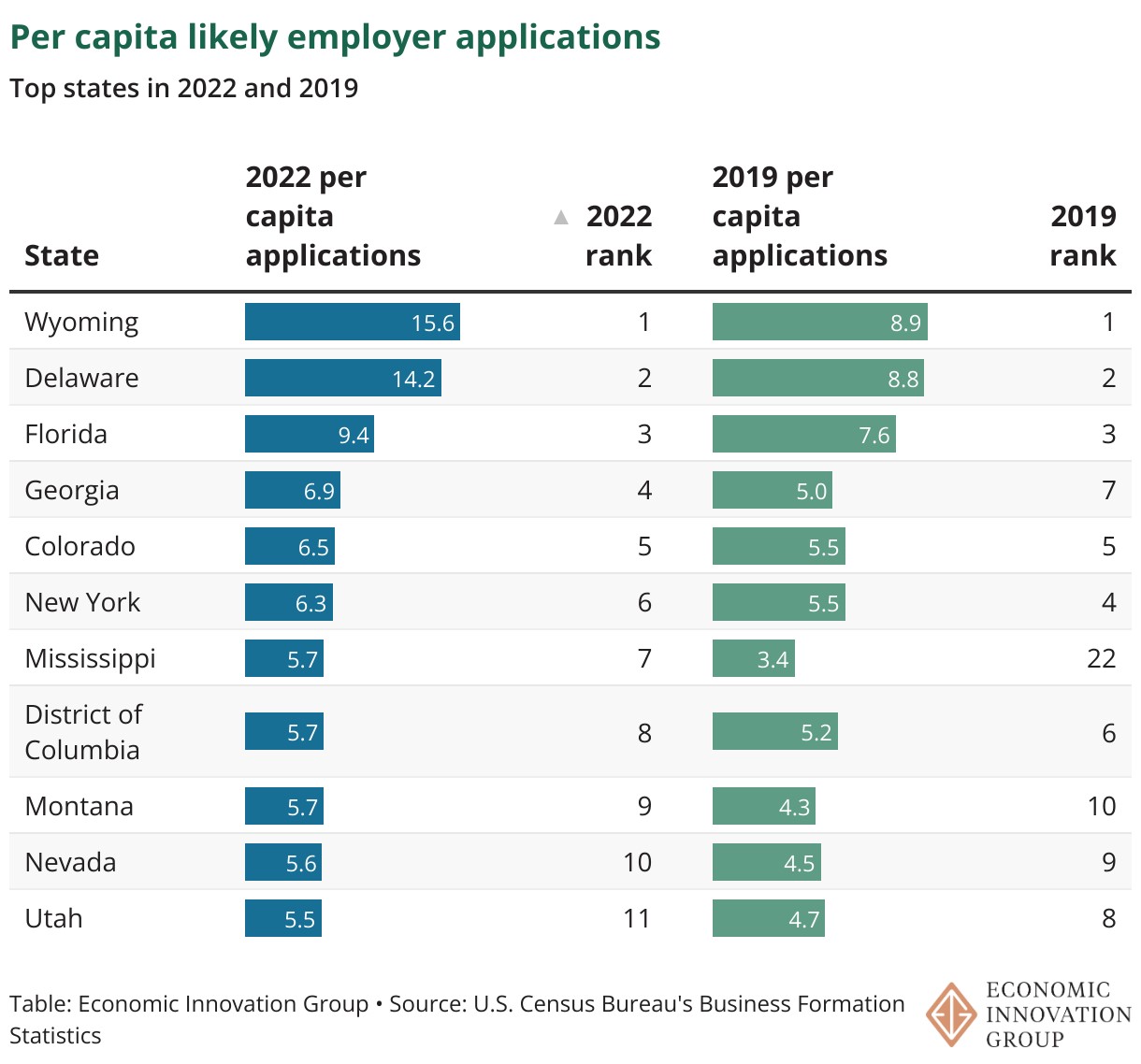Last year had the second highest number of applications to form new US businesses likely to hire employees in recorded history: With almost 1.7 million such applications, 2022 trailed only 2021, which saw 1.8 million.
That’s a 28% increase over 2019 (considered the “pre-pandemic baseline”) according to an Economic Innovation Group (EIG) analysis of the US Census Bureau’s Business Formation Statistics for 2022.

Likely employers are a fraction of the number of all new business applications, which hit 5.1 million in 2022, but are potentially the most economically impactful, as job creators.
Read the reportEIG recently hosted entrepreneurship experts Dr. Robert Litan, former director of research at Bloomberg Government and senior fellow at the Brookings Institution, and John C. Haltiwanger, professor of economics at the University of Maryland and former chief economist of the US Census Bureau, to discuss the EIG analysis.
Here are some takeaways from the discussion:
Dynamism is good for job growth
A trend of economic dynamism is an important factor in job growth, Litan said. What does that mean?
“Dynamism is essentially how fast technological change or productivity is driving our economy,” he said. “And the reason, of course, that we care about productivity is that it drives the increase over time in average living standards. It doesn’t say anything about how gains growth are distributed, which is another subject, but you still want a dynamic economy, because the faster economies grow, [the faster] they can afford to do all kinds of things. And on balance, more people are going to get richer over time the more productive economies are.”
Entrepreneurs have historically driven change and growth in the economy. We’re seeing something similar now.
“If you look at the major innovations in the last few 100 years, the things that have really driven growth in communications, telegraph, telephone, the internet, the automobile, airplane, etc., the one thing you find in common with all these really huge innovations, is that they were started by new firms,” Litan said. It follows that “if we really want to power our economy going forward, we need to help startups.”
This, following the 2010s, a decade that represented one of America’s least active periods for entrepreneurship. While three years of data in an unprecedented era doesn’t quite spell prediction, it could be the start of a trend of increasing entrepreneurship.
Intra-US migration impacted growth
One observation from the EIG analysis is that states not typically seen as entrepreneurial centers like Wyoming, Montana and Nevada are among those with the most entrepreneurial growth, a trend that that was likely the result of the pandemic. The rise of remote work changed tech migration patterns, and these states may have become “destination states” as would-be entrepreneurs left places like California.
“I think a very powerful driver here is that there are pandemic nomads that moved and they realized, ‘Hey, I don’t want to work for a company anymore. I’m just gonna go ahead and start a business,'” Litan said.

Remote work is changing where businesses pop up
While some companies are pushing to get employees back into their in-person offices, the remote work landscape that for many began as a temporary way to keep working during emergency lockdowns is not likely to disappear anytime soon.
That continues to impact downtown areas that were packed with commuters during the day pre-pandemic. It also opens up business opportunities in areas that used to have fewer people during the day, such as the suburbs and commutable rural areas.
“Remote work, or at least hybrid work, is here to stay and I think that that’s had a huge impact on the daytime population and where they’re spending their time,” Haltiwanger said. Some of these changes come from “individuals who didn’t necessarily move but are in the suburbs, and are spending a much greater fraction of their time in the suburbs than they used to.”
With daytime populations shifting from downtown business centers to surrounding neighborhoods and suburban areas, and new businesses increasingly operating from those surrounding areas, big cities aren’t the driver for new business growth that they once were.
“Manhattan was up towards the top in terms of an attractive place to start a new business, but not now,” Haltiwanger said. “I think a whole bunch of things are going on. People who are working from home, don’t want to go out to eat at lunch, they still want to go to the gym, they still want to go get various other kinds of support services and so on. So I think I think actually some of this is indirectly an impact of the changing technology and the changing lifestyle for very traditional businesses — an increase restaurants, for example, in your local community.”
Why now?
Clearly, the numbers from the past five years show that the pandemic made a huge impact on the rate of new businesses. Emergency funding like the CARES Act made supporting entrepreneurship one of its priorities.
“We can look back on the pandemic period now and see that entrepreneurship was a really useful safety net for people with all the disruptions that have gone on in the economy and individual life over the past three years,” Haltiwanger said. “Unprecedentedly large numbers of Americans did strike out on their own, in part because they had the financial security to do so during the pandemic era, which was a very unusual recession where financial markets actually did quite well and prices were really high.”
To keep the growth trajectory, continued support from policymakers will be necessary. That could include preventing noncompete agreements that previously blocked professionals from starting their own companies, or “portable” benefits or retirement accounts — “because clearly, there’s a big shock and push in that direction.”
Watch the full presentation here:







